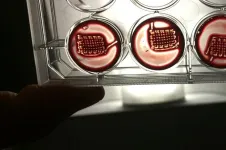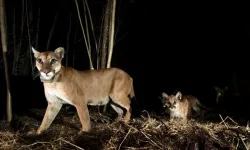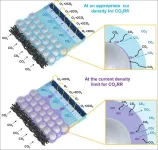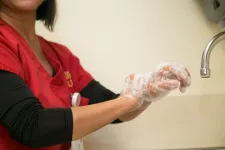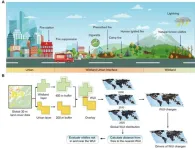(Press-News.org) In what could one day become a new treatment for epilepsy, researchers at UC San Francisco, UC Santa Cruz and UC Berkeley have used pulses of light to prevent seizure-like activity in neurons.
The researchers used brain tissue that had been removed from epilepsy patients as part of their treatment.
Eventually, they hope the technique will replace surgery to remove the brain tissue where seizures originate, providing a less invasive option for patients whose symptoms cannot be controlled with medication.
The team used a method known as optogenetics, which employs a harmless virus to deliver light-sensitive genes from microorganisms to a particular set of neurons in the brain that can be switched on and off with pulses of light.
It is the first demonstration that optogenetics can be used to control seizure activity in living human brain tissue, and it opens the door to new treatments for other neurological diseases and conditions.
“This represents a giant step toward a powerful new way of treating epilepsy and likely other conditions,” said Tomasz Nowakowski, PhD, an assistant professor of neurological surgery and a co-senior author of the study, which appears Nov. 15 in Nature Neuroscience.
Subduing epilepsy’s spikes
To keep the tissue alive long enough to complete the study, which took several weeks, the researchers created an environment that mimics conditions inside the skull.
John Andrews, MD, a resident in neurosurgery, placed the tissue on a nutrient medium that resembles the cerebrospinal fluid that bathes the brain.
David Schaffer, PhD, a biomolecular engineer at UC Berkeley found the best virus to deliver the genes, so they would work in the specific neurons the team was targeting.
Andrews then placed the tissue on a bed of electrodes small enough to detect the electrical discharges of neurons communicating with each other.
When the brain is acting normally, neurons send signals at different times and frequencies in a predictable, low-level chatter. But during a seizure, the chatter synchronizes into loud bursts of electrical activity that overwhelm the brain’s casual conversation.
The team hoped to use the light pulses to prevent the bursts by switching off neurons that contained light-sensitive proteins.
Remote-control experimentation
First, the team needed to find a way to run their experiments without disturbing the tissue. The tiny electrodes were only 17 microns apart – less than half the width of a human hair – and the smallest movement of the brain slices could skew their results.
Mircea Teodorescu, PhD, an associate professor of electrical and computer engineering at UCSC and co-senior author of the study, designed a remote-control system to record the neurons’ electrical activity and deliver light pulses to the tissue.
Teodorescu’s lab wrote software that enabled the scientists to control the apparatus, so the group could direct experiments from Santa Cruz on the tissue in Nowakowski’s San Francisco lab.
That way, no one needed to be in the room where the tissue was being kept.
“This was a very unique collaboration to solve an incredibly complex research problem,” Teodorescu said. “The fact that we actually accomplished this feat shows how much farther we can reach when we bring the strengths of our institutions together."
New insight into seizures
Optogenetics enables researchers to zoom in on discrete sets of neurons.
The group could see which types of neurons and how many of them were needed to start a seizure. And they determined the lowest intensity of light needed to change the electrical activity of the neurons in live brain slices.
The researchers could also see how interactions between neurons inhibited a seizure.
Edward Chang, MD, the chair of Neurological Surgery at UCSF, said these insights could revolutionize care for people with epilepsy.
“I believe that in the future, we won’t have to do that if we use this kind of approach,” Chang said who along with Nowakowski is a member of the UCSF Weill Institute for Neurosciences.
“We’ll be able to give people much more subtle, effective control over their seizures while saving them from such an invasive surgery.”
Authors: Additional authors on the study: David Shinn, Albert Wang, Matthew Keefe,PhD, Kevin Donohue, Hanh Larson, Kurtis Auguste, MD, Vikaas Sohal, MD, PhD, and Cathryn Cadwell, MD, PhD of UCSF, Jinghui Geng, Kateryna Voitiuk, Matthew Elliott, Ash Robbins, Alex Spaeth, Daniel Solis, Jessica Sevetson, PhD, Drew Ehrlich, Sofie Salama, PhD, Tal Sharf, PhD and David Haussler, PhD, of UCSC, and Lin Li and Julio Rivera-de Jesus of UC Berkeley.
Funding: This research was supported by the National Institutes of Health (grants 5R25NS070680-13, UF1MH130700, R01NS123263, R01MH120295, T32HG012344, K08NS126573, K12GM139185 and LRP0000018281), the National Science Foundation (grants 2034037, CNS-1730158, ACI-1540112, ACI-1541349 and OAC-1826967), the Schmidt Futures Foundation (SF 857), Weill Neurohub grant U01NS132353, the Esther A & Joseph Klingenstein Fund, the Shurl and Kay Curci Foundation, the Sontag Foundation, and a gift from the William K. Bowes Jr Foundation.
About UCSF: The University of California, San Francisco (UCSF) is exclusively focused on the health sciences and is dedicated to promoting health worldwide through advanced biomedical research, graduate-level education in the life sciences and health professions, and excellence in patient care. UCSF Health, which serves as UCSF's primary academic medical center, includes top-ranked specialty hospitals and other clinical programs, and has affiliations throughout the Bay Area. UCSF School of Medicine also has a regional campus in Fresno. Learn more at ucsf.edu, or see our Fact Sheet.
###
Follow UCSF
ucsf.edu | Facebook.com/ucsf | YouTube.com/ucsf
END
How optogenetics can put the brakes on epilepsy seizures
Researchers at UCSF, UCSC and Berkeley combine gene therapy with optogenetics to curb abnormal neural activity.
2024-11-15
ELSE PRESS RELEASES FROM THIS DATE:
Children exposed to antiseizure meds during pregnancy face neurodevelopmental risks, Drexel study finds
2024-11-15
Children born to mothers who take antiseizure medications to manage seizures and psychiatric conditions during pregnancy may face increased risks of neurodevelopmental conditions, according to new data from researchers at Drexel’s Dornsife School of Public Health.
The current work -- using data from more than three million children from the United Kingdom and Sweden, including 17,495 who were exposed to antiseizure medications during pregnancy -- found that children exposed to the antiseizure drug lamotrigine ...
Adding immunotherapy to neoadjuvant chemoradiation may improve outcomes in esophageal cancer
2024-11-15
Bottom Line: In patients with unresectable, locally advanced esophageal cancer, the triple combination of radiation, chemotherapy, and immunotherapy made tumors more amenable to surgery, which was associated with significantly improved outcomes.
Journal in Which the Study was Published: Clinical Cancer Research, a journal of the American Association for Cancer Research.
Background: “Curative resection unequivocally serves as the cornerstone for treating resectable esophageal squamous cell carcinoma (ESCC); ...
Scientists transform blood into regenerative materials, paving the way for personalized, blood-based, 3D-printed implants
2024-11-15
Scientists have created a new ‘biocooperative’ material based on blood, which has shown to successfully repair bones, paving the way for personalised regenerative blood products that could be used as effective therapies to treat injury and disease.
Researchers from the Schools of Pharmacy and Chemical Engineering at the University of Nottingham have used peptide molecules that can guide key processes taking place during the natural healing of tissues to create living materials that enhance tissue regeneration. The research published today in Advanced ...
Maarja Öpik to take up the position of New Phytologist Editor-in-Chief from January 2025
2024-11-15
The New Phytologist Foundation is delighted to announce that Professor Maarja Öpik will take up the position of Editor-in-Chief of New Phytologist from January 2025 for an initial term of five years.
Maarja has served as a member of New Phytologist's editorial board since 2013 and is Professor of Molecular Ecology and Director of the Institute of Ecology and Earth Sciences at the Faculty of Science and Technology at the University of Tartu, Estonia.
Maarja’s research addresses the interactions between plants and mycorrhizal fungi, with ...
Mountain lions coexist with outdoor recreationists by taking the night shift
2024-11-15
Mountain lions in greater Los Angeles are proactively shifting their activity to avoid interacting with cyclists, hikers, joggers and other recreationists, finds a study from the University of California, Davis, Cal Poly Pomona and the National Park Service.
The study, published Nov. 15 in the journal Biological Conservation, found that mountain lions living in areas with higher levels of human recreation were more nocturnal than lions in more remote regions who were more active at dawn and dusk. The authors said their findings offer a hopeful example of human-wildlife coexistence amid a large, dense human population.
“People are increasingly enjoying recreating ...
Students who use dating apps take more risks with their sexual health
2024-11-15
In May, the WHO raised the alarm over the rise in incidence of sexually transmitted illnesses (STIs) in many regions of the world, currently running at more than a million new cases per day. Among high-income countries, the US has one of the highest prevalences of STIs, and this problem is getting worse. For example, the incidence of chlamydia has more than doubled since 2000, while gonorrhea increased by 40% and syphilis by 400%. The highest prevalence is among young adults between 20 and 34 years of age.
Over ...
Breakthrough idea for CCU technology commercialization from 'carbon cycle of the earth'
2024-11-15
The research team led by Dr. Hyung-Suk Oh and Dr. Woong Hee Lee at the Clean Energy Research Center at Korea Institute of Science and Technology (KIST, President Sang-Rok Oh) has developed a silver-silica composite catalyst capable of reversible local pH control through a silica-hydroxide cycle, inspired by Earth’s natural cycles. This research draws inspiration from the carbonate-silicate cycle, known as the Earth’s inorganic carbon cycle, where carbon dioxide (CO₂) maintains balance. CO₂ is removed from ...
Keck Hospital of USC earns an ‘A’ Hospital Safety Grade from The Leapfrog Group
2024-11-15
LOS ANGELES — Keck Hospital of USC earned an “A” Hospital Safety Grade from The Leapfrog Group, an independent national nonprofit watchdog focused on patient safety.
This is the ninth “A” grade the hospital has received since 2019.
“An ‘A’ grade once again puts Keck Hospital among the safest hospitals in the nation, and reflects the hospital’s dedication to maintaining the highest standards of quality and safety protocols,” ...
Depression research pioneer Dr. Philip Gold maps disease's full-body impact
2024-11-15
Bethesda, Maryland, USA, 14 November 2024 – A landmark paper by distinguished neuroendocrine psychiatrist Dr. Philip W. Gold, published in Brain Medicine's Seymour Reichlin Centenary Festschrift collection, presents a masterful synthesis of how depression fundamentally alters the body's stress response systems, challenging long-held views of the condition.
The Viewpoint Review, published online November 14, 2024, represents a culmination of Dr. Gold's pioneering work in neuroendocrine psychiatry and honors the centenary of Dr. Seymour Reichlin, a foundational figure in neuroendocrinology whose ...
Rapid growth of global wildland-urban interface associated with wildfire risk, study shows
2024-11-15
Rapid human expansion into natural landscapes, resulting in the growth of the wildland-urban interface (WUI), has heightened risks associated with wildfires.
Prof. WANG Jianghao’s team from the Institute of Geographic Sciences and Natural Resources Research of the Chinese Academy of Sciences has recently mapped global WUI changes in 2000, 2010, and 2020, revealing alarming upward trends in WUI areas.
This work, published in Science Advances, provides critical insights into how urbanization can intensify potential wildfire risks faced by people worldwide.
Against ...
LAST 30 PRESS RELEASES:
Injectable breast ‘implant’ offers alternative to traditional surgeries
Neuroscientists devise formulas to measure multilingualism
New prostate cancer trial seeks to reduce toxicity without sacrificing efficacy
Geometry shapes life
A CRISPR screen reveals many previously unrecognized genes required for brain development and a new neurodevelopmental disorder
Hot flush treatment has anti-breast cancer activity, study finds
Securing AI systems against growing cybersecurity threats
Longest observation of an active solar region
Why nail-biting, procrastination and other self-sabotaging behaviors are rooted in survival instincts
Regional variations in mechanical properties of porcine leptomeninges
Artificial empathy in therapy and healthcare: advancements in interpersonal interaction technologies
Why some brains switch gears more efficiently than others
UVA’s Jundong Li wins ICDM’S 2025 Tao Li Award for data mining, machine learning
UVA’s low-power, high-performance computer power player Mircea Stan earns National Academy of Inventors fellowship
Not playing by the rules: USU researcher explores filamentous algae dynamics in rivers
Do our body clocks influence our risk of dementia?
Anthropologists offer new evidence of bipedalism in long-debated fossil discovery
Safer receipt paper from wood
Dosage-sensitive genes suggest no whole-genome duplications in ancestral angiosperm
First ancient human herpesvirus genomes document their deep history with humans
Why Some Bacteria Survive Antibiotics and How to Stop Them - New study reveals that bacteria can survive antibiotic treatment through two fundamentally different “shutdown modes”
UCLA study links scar healing to dangerous placenta condition
CHANGE-seq-BE finds off-target changes in the genome from base editors
The Journal of Nuclear Medicine Ahead-of-Print Tip Sheet: January 2, 2026
Delayed or absent first dose of measles, mumps, and rubella vaccination
Trends in US preterm birth rates by household income and race and ethnicity
Study identifies potential biomarker linked to progression and brain inflammation in multiple sclerosis
Many mothers in Norway do not show up for postnatal check-ups
Researchers want to find out why quick clay is so unstable
Superradiant spins show teamwork at the quantum scale
[Press-News.org] How optogenetics can put the brakes on epilepsy seizuresResearchers at UCSF, UCSC and Berkeley combine gene therapy with optogenetics to curb abnormal neural activity.
